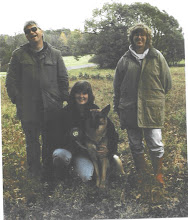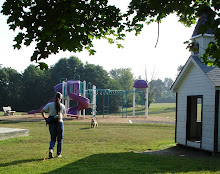Wondering if you're ready to try for your TD this fall?
Read on and find out...
You and your dog reliably and confidently do “blind tracks.”
This means someone else lays the track, no corner markers of any kind and then your tracklayer walks behind you and says absolutely nothing as you run the entire track.
Your dog confidently starts at all angles of legal approach to the flag.
Dogs learn what we teach them, and if we always approach a track so it is straight in front of the dog, then that’s what the dog thinks will always happen. I start angled approaches from the very beginning so I do not have to unteach something I should not have taught in the first place.
You and your dog reliably and confidently run tracks that are two hours old.
While most TD tracks are run at around 45 minutes, a slow team or two can push the later tracks up in age. You and your dog should be confident at two hours; if you were one of my students, I’d want you confident at 2.5 hours.
You can handle your dog while looking at the ground just in front of you, reading your dog’s behavior through the tracking line.
If it’s hard to get a blind track laid, then try this. Start your dog and look down at the ground. Follow and stop as the tension on the leash tells you to do and see how you do. This can be a very informative game.
Your dog reliably indicates articles in a way you can easily detect.
This means your dog stops himself when he gets to an article. It’s easy, if you lay the track yourself, to slow down or increase tension on the lead or move up the lead a bit or restrain your dog when the article nears. Easy but unhelpful as your dog isn’t learning to stop himself. So work hard not to indicate the article in anyway yourself, so your dog can learn to do his job himself.
Your dog works tracks enthusiastically without any food on the track itself.
Using food too much for too long can mean some dogs really don’t track well, or soon stop tracking, if food doesn’t appear on a regular basis in the track. While food can and should be used throughout training to reward increasingly specific behaviors, it should be used variably so your dog does not come to depend upon it in any way.
You can smoothly and briefly restrain your dog when he is on track or working a corner and he will lean into his harness and give you a good pull in the right direction.
At some point on a tracking test you are bound to get confused, second guess your dog and restrain him when he is correct. Luckily, you can train your dog to handle such moments using what I lovingly refer to as “dumb handler exercises.” This concept should be a part of every team’s development just as soon as the dog understands the task and is working enthusiastically.
You can follow your dog off track and, when he realizes he is off, he can refind the track and start off again with confidence.
Your dog leads and you follow, in tracking. So when your dog takes you off course, how quickly can you recognize his loss of scent signal and then, once you have planted your feet, how quickly can your dog problem-solve himself back to the track? Answer to both should be “quickly.”
Your dog can search for scent for at least three minutes without losing focus or enthusiasm.
This one can be difficult to set up - running acute turns up a hill can set up the situation - but whenever your dog is hunting for scent, relax and smile: this is a great variable for him to work. Try to keep your feet planted and your mouth shut - let him work. If he wanes, you can encourage, but until then, let him be.
You and your dog can confidently and successfully work a variety of cover and changes of cover including: sidewalks, bike and jogging paths, through openings between fields and from short to taller grass and back again.
Due to increasingly limited fields for tracking, the AKC loosened the rules around TD cover changes. So now, be ready for everything that is legal, and I would do some training on sand and gravel as well.
Your dog can sit in the car for hours, be taken out for walks and put back and still work the track confidently.
Some dogs are “rules” dogs - they believe what we teach them and are thrown off when things change. So if your dog is always tracked when taken out of the car at the tracking fields, he can be surprised when, at a test, he is taken out and then put back up again. Practicing this periodically can prevent this from causing confusion on test day.
Your dog works confidently in heat, rain and everything in between.If you are a weather wimp, expect your dog’s tracking to be weather dependent. As my mentor, Judge Lily Mummert, used to say to me when I moaned about tracking in a downpour. “Do you know what the weather will be test day?” And she was right. Again.
Your dog works confidently at all hours of the day.
As per above, if your dog only tracks in the early hours, he may be thrown off by a high noon start time on test day. Mix up tracking times during training so this never becomes an issue.
You know the AKC rules, understand what is and isn’t “guiding” and how you can legally help your dog when he or she loses the scent.
It’s your job, as the human, to know the rules. It’s a heartbreak when a team who is doing well fails because of human error. It happens, but it doesn’t have to. Get a copy of the AKC rules. Read them, then if you don’t understand, ask people who do until you do. You’ll be glad you did on test day.
You can answer a confident YES to all of the above?
You’re ready to test!
 This morning I started
Ramble tracking. I've been looking forward to tracking with Ramble since before
I got him. By five weeks old he was showing a strong inclination to follow
scent trails, unlike his brother who usually had his head up while he ran around.
That was just one of the many reasons I knew Ramble was the pup for me.
This morning I started
Ramble tracking. I've been looking forward to tracking with Ramble since before
I got him. By five weeks old he was showing a strong inclination to follow
scent trails, unlike his brother who usually had his head up while he ran around.
That was just one of the many reasons I knew Ramble was the pup for me.











